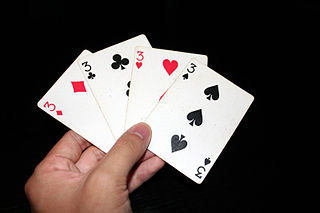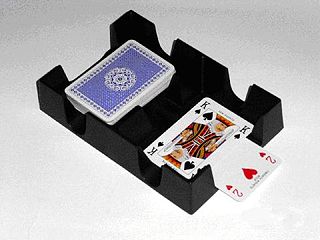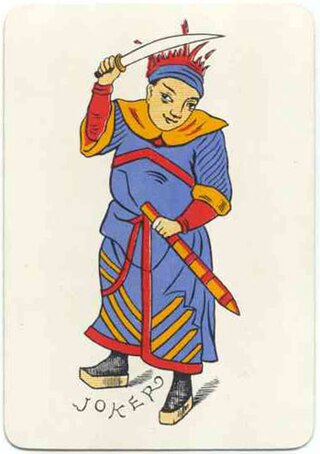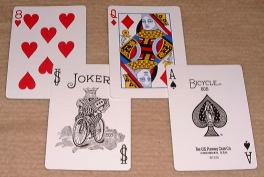
A wild card in card games is one that may be used to represent any other playing card, sometimes with certain restrictions. Jokers are often used as wild cards, but other cards may be designated as wild by the rules or by agreement. In addition to their use in card games played with a standard pack, wild cards may also exist in dedicated deck card games, such as the 'Master' card in Lexicon.

Gin rummy, or simply gin, is a two-player card game variant of rummy. It has enjoyed widespread popularity as both a social and a gambling game, especially during the mid twentieth century, and remains today one of the most widely-played two-player card games.

Bezique or bésigue is a 19th-century French melding and trick-taking card game for two players that came to Britain and is still played today. The game is derived from piquet, possibly via marriage (sixty-six) and briscan, with additional scoring features, notably the peculiar liaison of the Q♠ and J♦ that is also a feature of pinochle, Binokel, and similarly named games that vary by country.

Canasta is a card game of the rummy family of games believed to be a variant of 500 Rum. Although many variations exist for two, three, five or six players, it is most commonly played by four in two partnerships with two standard decks of cards. Players attempt to make melds of seven cards of the same rank and "go out" by playing all cards in their hands. It is "the most recent card game to have achieved worldwide status as a classic".

Robbers' rummy is a card game for two or more players. It is a variant of German Rummy dating to the early 20th century. Being derived from normal rummy, it emphasises arrangement of cards based on card matching rules, while abandoning the notions of card discards and scoring entirely.

500 rum, also called pinochle rummy, Michigan rummy, Persian rummy, rummy 500 or 500 rummy, is a popular variant of rummy. The game of canasta and several other games are believed to have developed from this popular form of rummy. The distinctive feature of 500 rum is that each player scores the value of the sets or cards they meld. It may be played by 2 to 8 players, but it is best for 3 to 5.

Desmoche is a popular rummy card game usually played for small stakes which closely resembles other games in the rummy family, like Conquian and gin rummy, more than poker. It was probably devised in Nicaragua in the first half of the 20th century.

Tiến lên is a shedding-type card game originating in Vietnam. It may be considered Vietnam's national card game, and is also played in the United States, sometimes under the names Viet Cong, VC, Thirteen, Killer, or 2’s.
Tonk, or tunk, is a matching card game, which combines features of knock rummy and conquian. Tonk is a relatively fast-paced game that can be played by 2-4 players. It can be played for just points or for money wagered.

Liverpool rummy is a multi-player, multi-round card game similar to other variants of rummy that adds features like buying and going out. It is played the same as Contract rummy, except that if a player manages to cut the exact number of cards required to deal the hand and leave a face-up card, then the cutting player's score is reduced by 50 points.

In card games, a meld is a set of matching cards, typically three or more, that earn a player points and/or allow them to deplete their hand. Melds typically come in sequences of ascending cards belonging to the same suit known as runs or sets/groups of cards of identical rank. Other ones may be marriage and bezique.
Three thirteen is a variation of the card game Rummy. It is an eleven-round game played with two or more players. It requires two decks of cards with the jokers removed. Like other Rummy games, once the hands are dealt, the remainder of the cards are placed face down on the table. The top card from the deck is flipped face up and put beside the deck to start the discard pile.

Khanhoo or kanhu is a non-partnership Chinese card game of the draw-and-discard structure. It was first recorded during the late Ming dynasty as a multi-trick taking game, a type of game that may be as old as T'ienkiu, revised in its rules and published in an authorized edition by Emperor Kao Tsung in 1130 AD for the information of his subjects. Meaning "watch the pot", it is very possibly the ancestor of all rummy games.

Ponytail Canasta is a card game that originated in Uruguay in the early 20th century and became popular in many countries, including the UnitedStates. It's typically played with two or more players, and involves forming melds of cards of the same rank and then "going out" by playing all of one's cards.

Penang rummy or si rummy is a variant of the rummy card game which originated in the Penang region of Malaysia in the late 1980s. The word si in Penang Hokkien language means 'dead'. It reflects the nature of the card game, where the hand is dead, with no drawing of new cards or exchanging of cards, throughout the whole game.

Marriage is a Rummy card game widely played in India. It uses three or more packs of playing cards.

Machiavelli is an Italian card game derived from Rummy and is usually played by 2 up to 5 players, but can be played by even a higher number. Because of its characteristics, it is not generally associated with gambling, but is instead a party game.
Algerian or Algerian Patience is a unique and difficult patience or card solitaire using two decks of playing cards. The object of the game is to build 8 foundations down from King to Ace or up from Ace to King in suit.

German Rummy or Rommé is the most popular form of the worldwide game, Rummy, played in Austria and Germany. It is a game for 2 to 6 players and is played with two packs of French playing cards, each comprising 52 cards and 3 jokers. There are no partnerships. In Germany, the Germany Rummy Association is the umbrella organisation for local rummy clubs and organises national competitions. The game is often just known as Rommé in Germany and Rummy in Austria.

Newmarket is an English card game of the matching type for any number of players. It is a domestic gambling game, involving more chance than skill, and emerged in the 1880s as an improvement of the older game of Pope Joan. It became known in America as Stops or Boodle before developing into Michigan. In 1981, Newmarket was still the sixth most popular card game in Britain.














